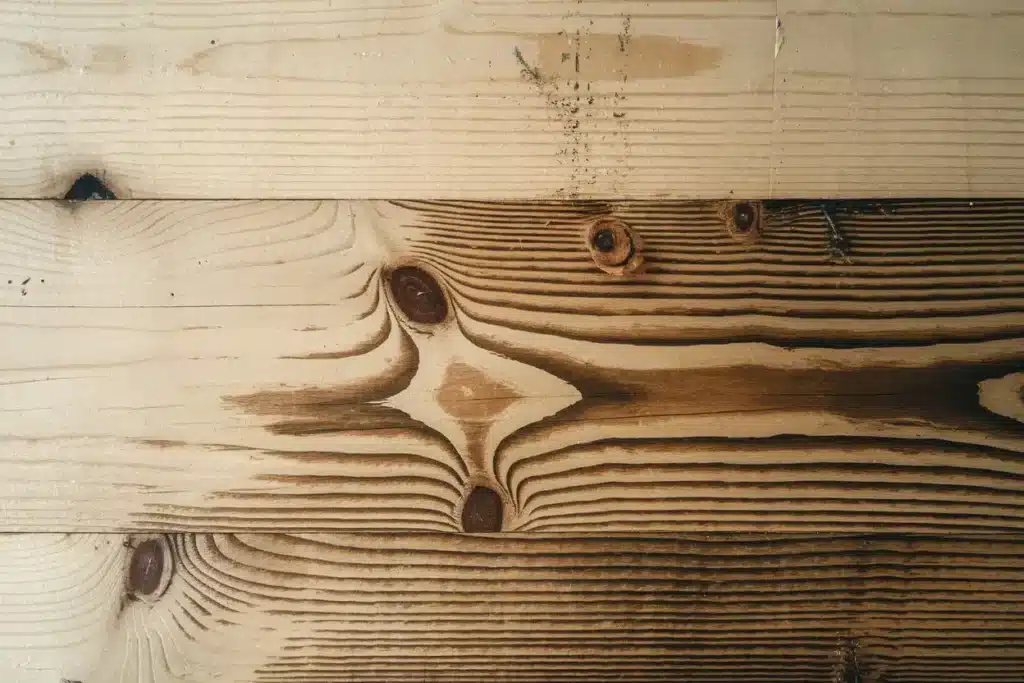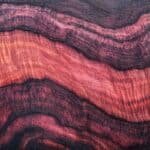So, you’re thinking about pine for your guitar, huh? Maybe you’ve seen a few pine-bodied builds floating around or heard that it’s “old-school cool” because, well, it’s been around forever.
Pine might not be the first tonewood that comes to mind when building or buying a guitar, but trust me—it’s worth considering. It’s pretty soft (which is not ideal), but it has its own pros too.
Let’s break it down and see what’s so cool about it (and what’s wrong about it too!).
So Is Pine Tonewood Good For Guitars?
1. Lightweight and Resonant: You’ll Thank Me Later

Let’s kick things off with one of pine’s biggest advantages: it’s light. Like, really light.
If you’re playing three-hour gigs or just like to noodle for hours at home, a pine guitar won’t have you reaching for painkillers after. You’ll feel the difference on your shoulder, and it might just be a game-changer for those longer sets.
This is caused by its density. You can read more about densities in our guide, but overall you need to know that the density of pine is somewhere between 350-500 kg/m3. It’s not that much, especially in comparison with other woods.
What’s interesting, different types of pine have different densities:
| Type Of Pine | Density (kg/m3) |
|---|---|
| Pine, Corsican | 510 |
| Pine, radiata | 480 |
| Pine, Scots | 510 |
| Pine, white | 350 – 500 |
| Pine, yellow | 420 |
Pine also has this cool resonance that you might not expect. It’s pretty vibrant and lively, meaning your tone will feel more “alive” than with some of the denser woods like mahogany. But don’t expect it to be as loud or boomy as, say, ash or maple.
2. Not Just for Cheap Furniture
Yeah, I know what you’re thinking. Pine—like, the stuff your grandma’s old dresser was made from? Yup. But don’t judge too quickly.
Pine is soft and workable, which means it’s easy to shape and modify (calling all DIY modders!). It’s an approachable wood, making it great for those of us who like to tinker with our guitars.
But this softness can also be a downside (more on that later).
In the meantime, you can watch a pine Telecaster demo below.
3. A Warm, Vintage Vibe
Tone-wise, pine lives in the midrange. It’s not going to give you the crystal-clear highs of maple or the deep, growling lows of mahogany. But what it will give you is warmth and balance. If you’re into rock, blues, or even some old-school country, pine can totally nail that vintage vibe.
It’s got this smooth, rounded sound that’s perfect for those genres. If you’re after a rich, warm tone with some retro character, pine might just be your secret weapon.
That said, if you’re looking for something super tight and punchy, you might want to keep looking. Pine’s charm is more in its laid-back, mellow sound.
Here’s an another great video to watch!
The Pros of Pine: Why You Should Give It a Shot
- Light as a Feather: We’ve already covered this, but it’s worth repeating. Pine is a great option if you want to save your back and shoulders during long sessions or gigs. No need for a chiropractor after a night of playing!
- Super Resonant: Pine has this lively, resonant quality that can make your guitar feel more “alive” in your hands. Every strum and pick attack will give you that satisfying vibe.
- Easy to Work With: Pine is soft and pliable, making it a dream for anyone who loves to mod their guitars. Whether you want to rout out space for new pickups or give it a custom finish, pine plays nice with your tools.
- Great for That Vintage Sound: Pine’s tonal profile really shines in the midrange. It’s got warmth, depth, and that “old-school” vibe that’s perfect for vintage rock and blues.
- Affordable: Let’s be real, pine is cheap—but in a good way. You can find some killer pine guitars for a fraction of what you’d pay for a mahogany or maple body.
The Cons: Pine Ain’t Perfect
Alright, I’ve sold you on the good stuff, but I wouldn’t be doing my job if I didn’t mention the downsides. Because yeah, pine has some flaws too. Let’s break ‘em down:
- Soft and Vulnerable: Remember how I said pine is soft and easy to work with? Well, that comes with a catch. Pine dents easily. You’re gonna get dings and scratches—fast. If you’re into the whole relic’d look, you’ll love it. If you’re precious about keeping your guitar pristine, maybe not so much.
- Limited Sustain: If you’re chasing those long, drawn-out notes with infinite sustain, pine might leave you wanting more. It’s not as dense as mahogany or maple, so you won’t get the same natural sustain those woods offer. But hey, that’s what pedals are for, right? 😉
- Not the Best for All Genres: Pine is great for vintage rock and blues, but if you’re playing metal or anything where you need tight, punchy lows or super-bright highs, you might find pine a little too mellow.
- Climate Sensitive: Pine can be a bit finicky when it comes to climate. Big temperature or humidity shifts can affect the wood, making it prone to warping or changing the action of your guitar over time. Keep it in a stable environment, or invest in a good case if you’re gigging with it.

FAQ
1. Does pine work well with all types of pickups?
Totally! Pine’s neutral tone makes it a solid match for both single coils and humbuckers. If you’re into vintage, warm tones, single coils will shine here. If you want a heavier, thicker tone, throw some humbuckers in there, and pine will hold its own.
2. Is pine durable enough for gigging?
Yes… with some caution. Pine is soft, so it’ll pick up dings and scratches quicker than harder woods like maple. But unless you’re thrashing around the stage like a maniac (you do you, though), it should be fine for regular gigging.
3. Can you get good sustain with pine?
Not really. Pine isn’t known for long sustain—it’s more about that warm, vintage tone. You can still get decent sustain if you boost it with the right gear, but it won’t hold a note like a mahogany or maple guitar.
4. How easy is it to finish or paint?
Super easy. Pine’s soft grain takes paint and finish like a champ. If you’re into DIY guitar mods, you’ll have no problem giving your pine guitar a slick, custom look.
5. Is pine a good choice for acoustic guitars?
Ehh, not so much. Pine’s soft and mellow tone doesn’t lend itself well to acoustic builds, where you need projection and resonance. Stick to spruce or mahogany for your acoustics, and leave pine for your electrics.
6. Which artists play pine guitars?
Pine isn’t as common as woods like mahogany or alder, but it’s been used in some iconic guitars. Fender even made some early prototypes using pine bodies. You won’t see too many famous artists rocking pine guitars, but trust me—it’s got the tone to keep up.
Final Thoughts: The Underrated Tonewood

So, there you have it—pine’s not just for cheap furniture anymore. It’s lightweight, resonant, and perfect for those of us who like a warm, vintage tone with a bit of character.
Sure, it’s not as tough as other woods, and the sustain might leave you wanting more, but for the price and the vibe? Pine’s a solid choice.
If you’re into DIY mods, vintage sounds, or just want something that won’t break your back (or your wallet), pine is worth a shot. Give it a go—you might be surprised at how well it fits your playing style.
And hey, if it was good enough for those early Fender prototypes, it’s probably good enough for you too 😉





